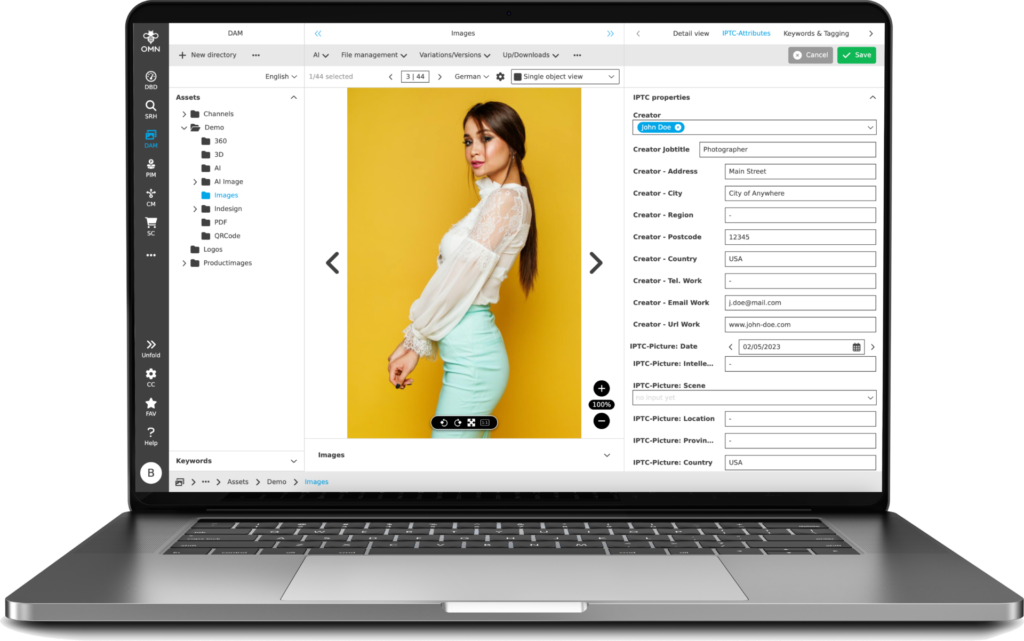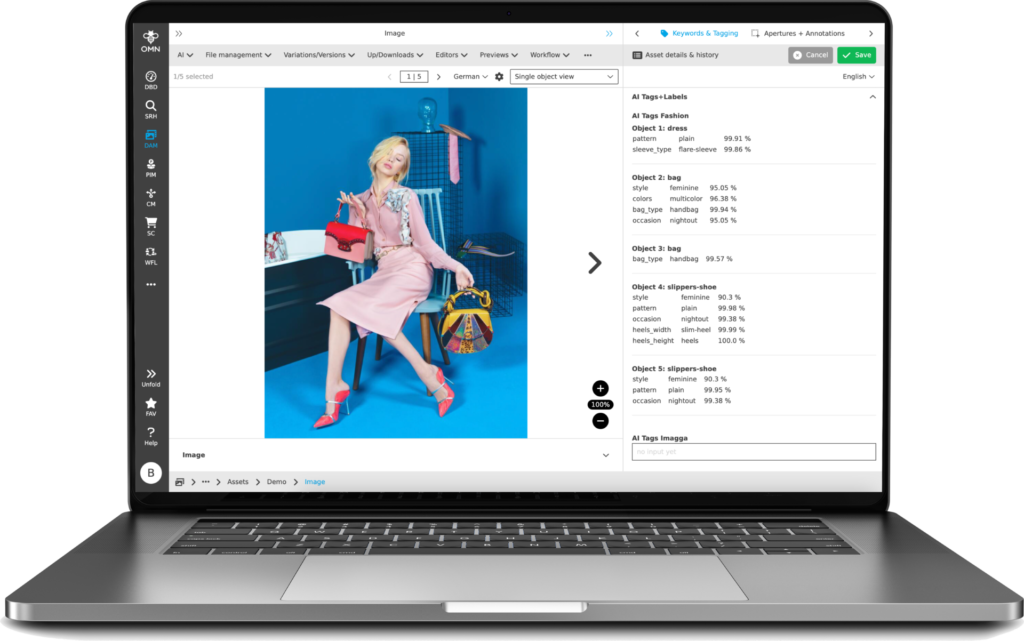So that your DAM project doesn’t fail
Digital Asset Management
In the digital world, where companies work with a flood of content and media every day, implementing a digital asset management (DAM) system seems like an easy decision. A DAM system is designed to help you organise, store and efficiently use digital resources. But despite the obvious advantages, many DAM projects fail. Why is that so? In this blog article, we look at the most common reasons why DAM projects fail and offer you solutions for overcoming these challenges.
Excursus: What is a DAM system?
DAM systems store and manage digital assets so that they can be retrieved directly when needed. Digital assets can be images, photos, logos, graphics, videos, audios, presentations or documents, i.e. all marketing materials of a company. The finished asset is the primary focus. Therefore, the main task of DAM systems is to store these assets in a central location, make them easy to find, version them, provide them to authorized persons and transfer them to the right systems (e.g. online store or marketplace).
Find out more about DAM here:

Why DAM Projects fail: Causes and Solutions
Today, there are a large number of different systems in the field of digital asset management (DAM). The realisation that the implementation of a DAM system is extremely beneficial for companies has now become established and is part of the general standard. But before you decide on a DAM system, you should consider the following stumbling blocks to ensure that your DAM project is a success.
1. Unclear goals and requirements
Reason: One of the main reasons for the failure of DAM projects is the lack of clearly defined goals and requirements. Without a clear understanding of what the DAM system should do and what specific needs it must fulfil, it will be difficult to plan and implement a successful project.
Solution: Before you start a DAM project, you should define clear goals and requirements. Identify the main problems that the system should solve and the specific functions that are required. Involve all relevant stakeholders in your company to ensure that all requirements are taken into account. The following questions may help you:
Question 1: Why do I need a DAM?
Possible answers could be:
- Organisation and management: I need a DAM to organise my digital content (images, videos, documents) centrally and make it easily accessible.
- Increased efficiency: A DAM helps me save time by simplifying the search process and content management.
- Consistency and quality: I want to make sure that all content used is up-to-date and of high quality to ensure a consistent brand presentation.
- Collaboration: I need a DAM to improve team collaboration and facilitate access to files for different departments or external partners.
- System integration: A DAM helps me to automate my touchpoints (online store, marketplace, etc.) with the right assets.
Question 2: What should my DAM be able to do?
Possible answers could be:
- Metadata management: The DAM should be able to manage metadata effectively so that content can be easily searched and filtered.
- Ease of use: It should provide an intuitive user interface that makes it easy to access and manage content.
- Security: The system must have robust security features to protect sensitive data.
- Integration: It should integrate seamlessly into existing systems and workflows, such as PIM (Product Information Management System), shop systems or marketing automation tools.
- Scalability: The DAM should be able to keep pace with the growth of the company and the increase in digital content.
Question 3: What features do I need at the moment?
Possible answers could be:
- Search function: A powerful search function is essential to quickly find the content you need.
- Versioning: The ability to save and manage different versions of an asset.
- User and role management: Detailed control over user access and authorisations.
- Automated workflows: Tools for automating approval and publication processes.
- Reporting and analyses: Functions to monitor and analyse the use and performance of digital content.
Question 4: Which features would I like to integrate in the future?
Possible answers could be:
- Artificial intelligence: Functions for automatic categorisation, tagging or editing of content using AI.
- Advanced analytics: In-depth analytics tools to better evaluate content usage and optimise strategy.
- Extended integrations: Connections to other company systems such as CRM (Customer Relationship Management) or social media management tools.
- Advanced collaboration tools: Tools for even better collaboration, such as joint editing or feedback functions in real time.
- Personalisation: Options for personalising content for different target groups.
Question 5: What is my available budget?
Possible answers could be:
- Cost-benefit analysis: I want a DAM system that offers good value for money and is within my budget.
- Long-term investment: I am prepared to invest in a DAM that fulfils my current and future needs, even if it means higher initial costs.
- Scalable costs: I prefer a system with scalable costs that allows me to add or remove features as needed.
- Total costs: In addition to the acquisition costs, I also take into account the ongoing costs for maintenance, updates and any necessary training.
2. Lack of Support from Management
Reason: Without the support of management, there is often a lack of the necessary resources, be it in the form of budget, time or employee commitment. DAM projects can be large and expensive, and without the support of senior management, they can quickly stall.
Solution: Secure the support of management right from the start. Present a solid business case that demonstrates the benefits of a DAM system and the expected ROI (return on investment). Regular updates and clear communication about the progress and successes of the project help to maintain support.

3. Inadequate Planning and Project Management
Reason: Many DAM projects fail due to poor planning and inadequate project management. Without a clear plan, clear responsibilities and continuous monitoring, the project can quickly spiral out of control.
Solution: Use proven project management methods and tools to plan and implement your DAM project. Define clear milestones and responsibilities and ensure that the project is regularly reviewed and adapted in order to be able to react to unexpected challenges.
4. Insufficient User Acceptance
Reason: No matter how good a DAM system is, if users do not accept it or do not use it properly, it will fail. Resistance to change, lack of training and lack of awareness of the benefits of the system can affect acceptance. Despite all the measures taken, there is a risk that users will continue to use the systems and storage locations they are familiar with. For example, marketing continues to use ‘SharePoint’, the agencies deliver media via an FTP server and sales stores presentations on drives.
Solution: Ensure all users are adequately trained and provide ongoing support to ease the transition. In order to promote the use of the new system, the benefits should be clearly communicated. Show concrete examples of how the DAM system improves workflows and makes them more efficient. Create incentives to use the new system and gradually reduce dependency on old filing locations. Regular feedback rounds and support sessions help to overcome initial hurdles and increase acceptance.

5. Inadequate Data Quality and Maintenance
Reason: A DAM system is only as good as the data that is stored in it. If the quality of the data is poor or it is not regularly updated and maintained, the system becomes ineffective and unreliable.
Solution: Implement strict guidelines and processes for data quality and maintenance. Ensure that all digital assets are correctly and consistently labelled with the corresponding metadata. Regular reviews and audits help to maintain data quality.
6. Lack of Integration with Other Systems
Reason: A DAM system rarely works in isolation. Without seamless integration with other systems, such as product information management systems (PIM), shop systems or marketing automation tools, silos can arise that impair efficiency.
Solution: Choose a DAM system that can be easily integrated into your existing system landscape. Work closely with IT experts to ensure that all systems communicate smoothly with each other. Plan the integration from the outset to avoid problems later on.

7. Lack of Structuring before Putting into Operation
Reason: A DAM system is a powerful tool, but it can only be as effective as the structure that underpins it. Without a clearly defined structure and organisation for managing digital assets, the system can become chaotic and confusing. This makes it difficult for users to find the files they need and work efficiently.
Solution: Before you put a DAM system into operation, you should develop a clear structure and organisational guidelines. Define how the digital assets should be categorised, named and indexed. Create a uniform taxonomy and metadata standards that are followed by all users. By defining these structures in advance, you ensure that the DAM system is well organised from the outset and can be used efficiently. Regular training and updates to these guidelines help to maintain the structure and make adjustments when requirements change.
Final thought: So that your DAM project doesn’t fail
DAM projects often fail for a combination of reasons. However, the main reason is usually not the implementation and set-up, but the maintenance of the data. The files often do not have a descriptive name and must first be tagged and categorised after import so that they can actually be found and used later. With a huge amount of data, this can quickly become an endless task. And when internationalisation comes into play, there really seems to be no end in sight.
Fortunately, support is now available: Artificial Intelligence (AI) is the magic word. AI services integrated into DAM systems take over the tedious tasks of categorisation, keywording and translation and significantly increase data quality compared to manual processing. The time saved is enormous.
If you are planning to introduce a DAM system, you should not postpone the topic of AI until later, but take it into account when researching suitable DAM systems. After all, the success of a DAM project depends on the day-to-day work, as new media is constantly being created. A successful DAM project requires commitment and continuous effort, but the benefits it offers are worth it.
Take a look at our OMN DAM and let us introduce you to the AI functions – free of charge and with no obligation: Request a demo

Would you like to get to know our OMN DAM?
EXPERIENCE OUR OMN DAM LIVE AND SEE ITS PERFORMANCE FOR YOURSELF!